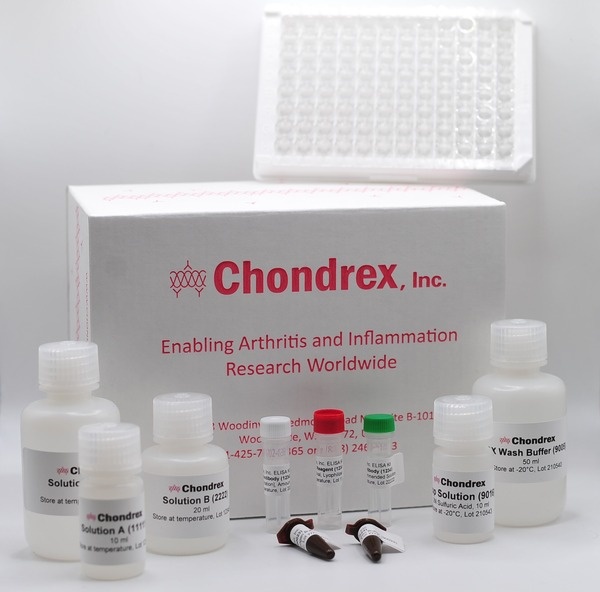Trypsin is a mammalian serine protease and a member of the PA Clan (proteases of a mixed nucleophile, superfamily A), the largest of the cysteine and serine protease families. The PA Clan, which also includes trypsin-like proteases, can hydrolyze positively-charged amino acid peptide bonds in polypeptide chains, specifically the carbonyl group on Arg or Lys (1), effectively degrading peptides and proteins. As such, trypsin produced by the pancreas plays a key role in facilitating protein digestion and absorbance of foods in the small intestine. It also regulates the gastrointestinal immune response by controlling microbicide concentrations in the intestinal lumen and maintaining the integrity of the epithelial barrier (2-3). Due to these capabilities, trypsin is widely used in protein or peptide-related research for synthesizing and sequencing peptides, maintaining cultured cells, and digesting proteins (4). Recently, it was reported that proteinases in house dust mites (HDM) promoted allergenicity to proteins, resulting in allergic reactions (5). This suggests that proteinases may play roles in the development of Type I allergies. In order to validate the study results, the ability to measure enzyme activity is critical.
Trypsin Activity Assay
| Product | Catalog # | Price (USD) | |
|---|---|---|---|
 |
Trypsin Activity Assay Kit | 3043 | 355.00 |
Chondrex, Inc. introduces a chromogenic Trypsin Activity Assay Kit (Catalog # 3043) which uses a Boc-Gln-Ala-Arg-pNA substrate to measure trypsin-like enzyme activity in 15 minutes or more (up to 120 minutes, depending on the enzyme activity in samples). The trypsin cleaves the carbonyl group in the Arg of the substrate, liberating p-nitroanilid (pNA) which produces a yellow color and can be quantified using optical density (6). This kit works for trypsin and any proteinase/peptidase which cleaves the substrate. Therefore, to accurately analyze a specific proteinase activity, it may be necessary to add proteinase inhibitors to inactivate other proteinases in samples (Figure 1). This kit, which employs a short assay time and a microplate format, is ideal for assaying many samples, as compared to traditional cuvette readings or gel assays (7). For more applications, please refer to published research references.

Figure 1. Proteinase Activities in House Dust Mite Samples from Two Different Vendors
HDM is composed of many different proteins, including proteinases such as cysteine protease (Der p1) and serine protease (Der p3) (8). The following enzyme assay illustrates the multi-proteases in HDM samples from two vendors. Cysteine proteinases activity were assayed with (triangle) or without (circle) pretreatment by 1M cysteine which is a cysteine proteinase activator. In addition, to obtain serine protease-specific activity values, a serine proteinase inhibitor (soybean trypsin inhibitor) was added to HDM samples (square).
Proteinase activity in HDM from Vendor 1 showed that cysteine activation drastically increased enzyme activity from almost no activity. Interestingly, this activation was not inhibited by the serine proteinase inhibitor. This result implies that cysteine proteinase accounts for most of the proteinase activity in the HDM from vendor 1. However, HDM vendor 2 showed a high proteinase activity level regardless of the cysteine activation step. Furthermore, the serine proteinase inhibitor treatment only inhibited about 50% of the proteinase activity. This result suggests that proteinase activity in HDM from vendor 2 may consist of 50% serine and 50% cysteine proteinase. Thus, the use of an appropriate protein inhibitor allows the user to selectively assay specific proteinase activities.
References
- C. Di, Serine proteases. IUBMB Life 61, 510-5 (2009)
- M. Bajaj-Elliott, Trypsin and host defence: a new role for an old enzyme. Gut 52, 166-7 (2003).
- D. Ghosh, E. Porter, B. Shen, S. Lee, D. Wilk, et al., Paneth cell trypsin is the processing enzyme for human defensin-5. Nat Immunol 3, 583-90 (2002).
- J. Mótyán, F. Tóth, J. Tőzsér, Research Applications of Proteolytic Enzymes in Molecular Biology. Biomolecules 3, 923-42 (2013).
- M. Reithofer, B. Jahn-Schmid, Allergens with Protease Activity from House Dust Mites. IJMS. 18, 1368-9 (2017).
- B. Erlanger, N. Kokowsky, W. Cohen, The preparation and properties of two new chromogenic substrates of trypsin. Arch Biochem Biophys 95, 271-8 (1961).
- Z. Zhao, P. Russell, Trypsin activity assay in substrate-specific one-and two-dimensional gels: A powerful method to separate and characterize novel proteases in active form in biological samples. Electrophoresis 24, 3284-8 (2003).
- E. Adam, K. Hansen, F. Astudillo, L. Coulon, F. Bex, et al., The house dust mite allergen Der p 1, unlike Der p 3, stimulates the expression of interleukin-8 in human airway epithelial cells via a proteinase-activated receptor-2-independent mechanism. J Biol Chem 281, 6910-23 (2006).